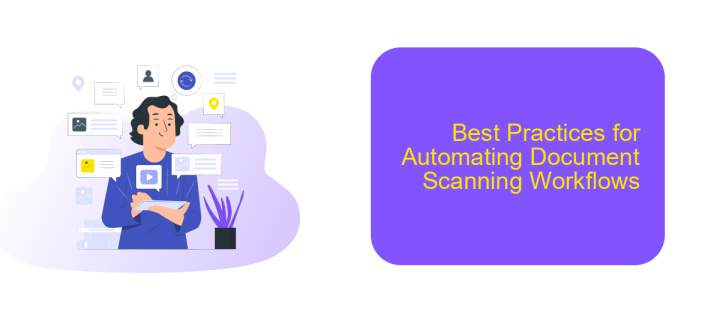Document Scanning Workflow Automation
In today's digital age, efficient document management is crucial for businesses of all sizes. Document scanning workflow automation streamlines the process of converting paper documents into digital formats, enhancing accessibility, reducing manual labor, and improving overall productivity. This article explores the benefits, key components, and best practices for implementing an automated document scanning workflow in your organization.
Introduction
In today's fast-paced business environment, automating document scanning workflows has become a necessity for increasing efficiency and reducing manual errors. The traditional methods of handling documents are not only time-consuming but also prone to mistakes, which can lead to significant operational setbacks. By implementing automated solutions, organizations can streamline their document management processes and improve overall productivity.
- Enhanced accuracy and reduced human error
- Time and cost savings
- Improved compliance and data security
- Seamless integration with existing systems
One of the key aspects of automating document scanning workflows is the integration of various systems and services. Tools like ApiX-Drive facilitate these integrations by connecting different applications and ensuring smooth data flow. This not only simplifies the setup process but also enhances the overall efficiency of the automation system. By leveraging such services, businesses can achieve a more cohesive and streamlined document management workflow.
Benefits of Automating Document Scanning Workflows

Automating document scanning workflows offers significant advantages, primarily in terms of efficiency and accuracy. Manual scanning processes are often time-consuming and prone to human error, leading to misfiled or lost documents. Automation streamlines the entire process, ensuring that documents are scanned, categorized, and stored correctly with minimal human intervention. This not only saves time but also enhances data accuracy, making it easier to retrieve and manage documents when needed.
Moreover, integrating automated scanning workflows with other business systems can further optimize operations. Services like ApiX-Drive facilitate seamless integration between various platforms, allowing scanned documents to be automatically uploaded to cloud storage, CRM systems, or other relevant applications. This integration reduces the need for manual data entry and ensures that all departments have access to up-to-date information. Ultimately, automating document scanning workflows leads to increased productivity, reduced operational costs, and improved overall efficiency.
Steps in Automating Document Scanning Workflows

Automating document scanning workflows can significantly enhance efficiency and accuracy in handling large volumes of documents. The process involves several key steps that ensure seamless integration and functionality.
- Assessing Requirements: Identify the specific needs and objectives of the document scanning workflow, including the types of documents, volume, and desired outcomes.
- Choosing the Right Tools: Select appropriate scanning hardware and software that support automation features. Consider compatibility with existing systems and the ability to handle various document formats.
- Setting Up Scanning Parameters: Configure scanning settings such as resolution, color depth, and file formats to ensure optimal quality and performance.
- Implementing OCR Technology: Integrate Optical Character Recognition (OCR) tools to convert scanned images into editable and searchable text, enhancing data accessibility.
- Integrating with Workflow Systems: Use services like ApiX-Drive to connect your scanning software with other business applications, streamlining data flow and reducing manual intervention.
- Testing and Optimization: Conduct thorough testing to identify any issues and optimize the workflow for maximum efficiency and reliability.
By following these steps, organizations can achieve a highly efficient and automated document scanning workflow, saving time and reducing errors. Leveraging integration services like ApiX-Drive can further enhance the process by ensuring seamless connectivity between different systems.
Best Practices for Automating Document Scanning Workflows

Automating document scanning workflows can significantly enhance efficiency and accuracy in handling large volumes of documents. To achieve the best results, it's essential to follow certain best practices that streamline the process and minimize errors.
First, ensure that your scanning hardware is capable of high-speed and high-resolution scanning to maintain quality and speed. Additionally, invest in OCR (Optical Character Recognition) technology to convert scanned images into editable and searchable text, which greatly enhances document management.
- Standardize document formats and naming conventions to ensure consistency.
- Implement robust error-checking mechanisms to catch and correct issues early.
- Utilize cloud storage solutions for easy access and backup.
- Integrate with automation tools like ApiX-Drive to connect various services and streamline workflows.
By following these best practices, organizations can create a more efficient and reliable document scanning workflow. Leveraging tools like ApiX-Drive for integration can further enhance the automation process, ensuring seamless connectivity between different systems and services.
Conclusion
The automation of document scanning workflows presents numerous benefits, including increased efficiency, reduced errors, and significant time savings. By leveraging advanced technologies such as optical character recognition (OCR) and machine learning, organizations can streamline their document processing tasks, ensuring that critical information is captured accurately and promptly. This transformation not only enhances productivity but also allows for better data management and retrieval, ultimately leading to improved decision-making processes.
Integrating these automated workflows with other business systems is crucial for maximizing their potential. Services like ApiX-Drive facilitate seamless integration by connecting various applications and automating data transfers between them. This ensures that scanned documents and extracted data are readily available across different platforms, further enhancing operational efficiency. As businesses continue to adopt digital transformation strategies, the role of automated document scanning workflows will become increasingly pivotal in achieving streamlined operations and maintaining a competitive edge.


FAQ
What is Document Scanning Workflow Automation?
How can I integrate Document Scanning Workflow Automation into my existing systems?
What are the benefits of automating document scanning workflows?
What types of documents can be automated in the scanning workflow?
How secure is Document Scanning Workflow Automation?
Do you want to achieve your goals in business, career and life faster and better? Do it with ApiX-Drive – a tool that will remove a significant part of the routine from workflows and free up additional time to achieve your goals. Test the capabilities of Apix-Drive for free – see for yourself the effectiveness of the tool.

